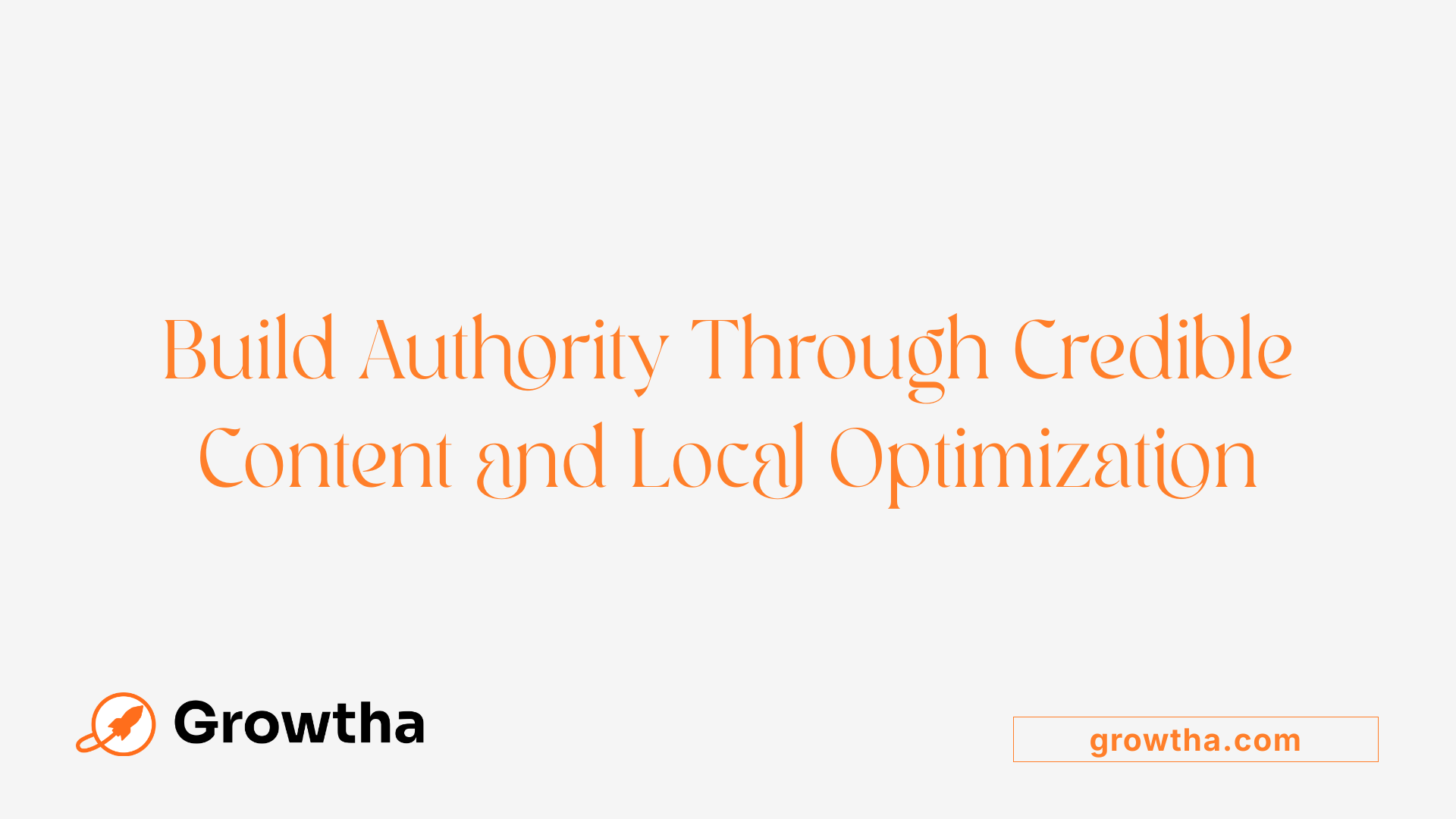SEO for New Healthcare Websites
Enhancing Visibility and Credibility for New Healthcare Practices


SEO for New Healthcare Websites
Understanding the Importance of SEO in Healthcare
In the rapidly evolving digital landscape, healthcare providers must prioritize search engine optimization (SEO) to attract and retain patients online. With more than 90% of traditional search traffic originating from Google, a well-structured SEO strategy is essential for establishing credibility, increasing visibility, and ensuring your practice reaches its target audience effectively.
Core Principles of Healthcare SEO

What are the main principles and best practices of healthcare SEO?
Healthcare SEO revolves around creating a website that is trustworthy, user-focused, and optimized for search engines to connect patients with the care they need. At the heart of this approach is developing high-quality, accurate content that adheres to Google’s E-E-A-T standards—Experience, Expertise, Authority, and Trustworthiness.
For healthcare providers, content must be credible, frequently updated, and reviewed by qualified medical professionals. This not only improves rankings but also builds patient trust. Additionally, technical SEO plays a crucial role, including optimizing website speed, ensuring mobile responsiveness, and structured data markup like schema tailored for medical content.
Local SEO is vital for attracting nearby patients. Strategies such as managing Google My Business profiles, utilizing local keywords, and encouraging positive reviews help healthcare practices appear prominently in local searches and map results.
Reputation management is also essential. Active monitoring and responding to reviews foster trust and influence search rankings. Since reputation affects patient decision-making, maintaining a positive online presence is a priority.
Given the sensitive nature of healthcare information, compliance with regulations like HIPAA, as well as transparency in content and data handling, is always necessary. Finally, ongoing measurement and adaptation through analytics—tracking metrics like organic traffic, keyword rankings, and user engagement—are critical to refining strategies.
In summary, effective healthcare SEO combines trustworthy, expert-approved content; technical and on-page optimization; strategic local SEO efforts; and reputation management. This integrated approach ensures practices can improve their online visibility ethically, attract new patients, and provide accessible, reliable healthcare information.
Key Elements of Successful Healthcare SEO

What are the key elements of healthcare SEO such as keywords, content quality, and technical optimization?
Effective healthcare SEO requires a balanced approach that integrates multiple components to enhance online visibility and trustworthiness.
Firstly, keyword research and implementation are crucial. Healthcare providers should identify relevant terms that patients frequently search, including general medical conditions, specific treatments, and location-based queries. Using these keywords strategically in website content, titles, meta descriptions, and headers helps search engines understand the site's relevance.
Secondly, high-quality, accurate, and comprehensive content is vital. Content must demonstrate expertise, authority, and trustworthiness—principles summarized in Google’s E-E-A-T guidelines. This means providing information reviewed by qualified medical professionals, citing reputable sources like WHO or CDC, and ensuring clarity and correctness. Regularly updated content addressing patient questions builds credibility and enhances search rankings.
Thirdly, technical optimization underpins all other efforts. This includes ensuring fast page loading speeds by optimizing images and scripts, making the site mobile-responsive, and structuring the website logically with clear navigation and internal linking. Incorporating schema markup—such as FAQ, physician, or treatment schemas—helps search engines better understand the content, improving visibility in rich snippets.
Additionally, off-site SEO tactics like building backlinks from respected healthcare sites and managing online reviews bolster authority. Optimizing local search profiles through Google My Business and maintaining consistent NAP (Name, Address, Phone number) information ensures the practice appears prominently in local search results.
In summary, successful healthcare SEO weaves together strategic keyword use, authoritative content, and robust technical foundations. Implementing these elements effectively attracts targeted patients, builds trust, and secures top rankings in search engine results.
Using SEO to Improve Healthcare Visibility

How is SEO used in healthcare?
In healthcare, search engine optimization (SEO) is vital for enhancing a practice's online presence and attracting new patients. It involves optimizing website content, structure, and local listings to rank higher in search engine results, especially on Google, which handles over a billion health-related searches each day.
Practices target relevant and often long-tail keywords that potential patients use when searching for specific medical services or information. High-quality, accurate content that addresses common patient questions helps improve authority and trustworthiness, following Google’s E-A-T (Experience, Expertise, Authority, Trustworthiness) principles.
Technical aspects such as site speed, mobile responsiveness, and clear site architecture ensure that search engines can crawl and index the website effectively. Building backlinks from reputable healthcare sites further boosts credibility and search rankings.
Monitoring SEO metrics like search rankings, organic traffic, and conversions helps practices refine their strategies over time. Engagement tools like Google Analytics allow for data-driven decisions to improve visibility and patient access.
Overall, healthcare SEO is a cost-effective, long-term marketing approach that enhances a practice’s credibility, helps build trust with patients, and makes healthcare services more accessible.
Improving SEO for a Newly Launched Healthcare Website

How to increase SEO on a new healthcare website?
Launching a new healthcare website can be challenging, but with targeted SEO strategies, you can boost your online visibility quickly. First, focus on website design and usability. Ensure your site is clean, intuitive, and easy to navigate, with a responsive mobile layout that caters to patients on smartphones or tablets.
Technical SEO essentials are critical. Optimize your site speed by compressing images, minimizing redirects, and choosing reliable hosting. Implement an SSL certificate to boost security, and create a logical site structure with clear internal links. Submitting an XML sitemap to Google Search Console ensures search engines can efficiently crawl and index your pages.
Content development plays a vital role. Conduct thorough keyword research to identify relevant terms that your target patients are searching for. Develop high-quality, accurate content—such as blogs, FAQs, and service pages—that incorporate these keywords naturally in titles, headers, and meta descriptions. Regularly update your content to reflect the latest medical guidelines or research.
Building backlinks from reputable health organizations, local directories, and industry blogs enhances your site's authority. Local SEO strategies are equally important—set up and optimize your Google My Business profile, keep your NAP (Name, Address, Phone Number) consistent across listings, and encourage satisfied patients to leave positive reviews.
Monitoring your SEO progress with tools like Google Search Console and Analytics will help you identify areas for improvement. Stay updated on emerging search engine optimization techniques through trusted sources and industry webinars. Combining these efforts will establish a strong foundation for your healthcare website’s online presence, attracting new patients and fostering trust.
Cost Considerations in Healthcare SEO
 Understanding the expenses involved in healthcare SEO is essential for medical practices and providers looking to allocate their marketing budgets efficiently.
Understanding the expenses involved in healthcare SEO is essential for medical practices and providers looking to allocate their marketing budgets efficiently.
Healthcare SEO typically costs between $1,500 and $5,000 monthly for comprehensive services tailored to medical websites. This range reflects the variation in scope, geographical coverage, and the sophistication of the strategies implemented. Smaller practices might find costs on the lower end with basic local SEO and content updates, whereas larger hospitals or multispecialty clinics may require extensive technical optimization, content creation, and ongoing link-building, driving prices upward.
The choice between agencies and in-house solutions can significantly influence costs. Outsourcing to specialized SEO firms often provides access to expert knowledge and advanced tools at a predictable monthly rate. In contrast, building an in-house team involves substantial upfront and ongoing expenses, with salaries exceeding $40,000 annually per staff member, along with costs for training and software.
Evaluating the return on investment (ROI) is crucial. Properly executed healthcare SEO can lead to increased visibility in local searches, higher website traffic, and more patient inquiries, ultimately boosting revenue. While initial investments might seem high, the long-term benefits of sustained search engine rankings and improved reputation management often outweigh costs.
For those considering budgeting, searching for reliable data on healthcare SEO costs and comparing different options can help in making informed decisions that align with their practice’s financial and growth objectives.
Unique Challenges in Healthcare SEO and Solutions

What challenges are specific to healthcare SEO, and how can they be addressed?
Healthcare SEO encounters several distinct hurdles that require tailored strategies for effective navigation. One of the foremost challenges is regulatory compliance. Regulations such as HIPAA in the United States and FDA standards impose strict guidelines on handling patient information, particularly concerning privacy and data security. These laws influence how healthcare websites can collect, display, and share patient data, making it essential to implement privacy safeguards and ensure all content and marketing practices adhere to legal standards.
Another significant obstacle is the need for highly accurate and trustworthy content. Medical information must be reliable to establish authority and credibility, aligning with Google’s E-A-T principles—experience, expertise, authority, and trustworthiness. Creating such content involves meticulous review by qualified healthcare professionals, supporting evidence from recent research, and clear citations from reputable sources like the CDC or WHO.
Technical issues also pose barriers to SEO success. Poor site architecture, slow loading speeds, and a lack of structured data prevent search engines from effectively crawling and indexing a website. These technical flaws can especially hamper local SEO efforts, which are crucial for attracting nearby patients through features like Google My Business and local citations.
Addressing these challenges involves conducting thorough SEO audits to identify and fix technical issues, using schema markup to enhance search understanding, and regularly optimizing site speed and mobile responsiveness. Developing content that complies with healthcare regulations while providing value and clarity to users is vital. Maintaining consistent NAP (Name, Address, Phone) information, actively managing online reviews, and focusing on local SEO techniques further enhance visibility.
Staying informed about evolving search trends and ensuring compliance with legal standards ultimately helps healthcare providers improve their online presence and connect effectively with their target patient base. Combining technical optimization, authoritative content, and reputation management creates a robust SEO strategy capable of overcoming healthcare-specific challenges.
E-E-A-T and Trust Building in Healthcare SEO

What is the significance of E-E-A-T principles in healthcare SEO?
The E-E-A-T principles—Experience, Expertise, Authority, and Trustworthiness—are fundamental in healthcare SEO because they guarantee that the health information presented is credible, accurate, and dependable. Given the sensitive nature of medical data and advice, search engines like Google use these signals to evaluate whether a website can positively influence users' health decisions.
Demonstrating strong E-E-A-T involves several strategies. Healthcare providers should highlight the qualifications and professional backgrounds of their medical staff, ensuring that content is authored or reviewed by licensed healthcare professionals. Citing reputable sources such as the WHO or CDC enhances credibility and shows a commitment to evidence-based information.
Website security is also crucial—using HTTPS protocols and transparent privacy policies build trust. Additionally, accumulating positive patient reviews and actively managing online reputation signals reinforce trustworthiness.
Implementing E-E-A-T principles not only boosts search engine rankings but also encourages patient confidence and engagement. It assures users that they are receiving reliable health guidance, which is especially significant for YMYL (Your Money, Your Life) healthcare websites. Overall, prioritizing E-E-A-T in healthcare SEO is essential for establishing authority, increasing visibility, and fostering patient trust.
Distinguishing Types of Healthcare Content and Their SEO Needs
 In healthcare SEO, understanding the difference between informational and service-oriented content is crucial for developing effective strategies.
In healthcare SEO, understanding the difference between informational and service-oriented content is crucial for developing effective strategies.
What distinguishes informational content from service-oriented content in healthcare SEO?
Informational healthcare content focuses on educating patients by providing accurate, comprehensive, and trustworthy medical information. This includes articles about various medical conditions, treatments, health tips, and general wellness advice. Such content aims to answer common patient questions, improve health literacy, and establish the site’s authority. To rank well on search engine results pages (SERPs), this type of content incorporates relevant keywords related to diseases, symptoms, procedures, and medical terminology, emphasizing expertise, authority, and trustworthiness—principles outlined in Google’s E-E-A-T guidelines.
On the other hand, service-oriented content promotes specific healthcare providers, clinics, or practice offerings. It emphasizes attracting local patients through location-specific keywords, detailed practice descriptions, and compelling calls to action like appointment booking or consultation requests. Reputation management plays a significant role here; managing and showcasing positive online reviews, displaying professional credentials, and including structured data help enhance local SEO and user trust.
Both content types require tailored approaches:
- Informational Content: Prioritize accuracy, depth, and authority. Use credible sources like WHO or CDC references, and ensure the content addresses frequent patient queries.
- Service Content: Focus on local SEO strategies, with optimized Google My Business profiles, structured data markup, and clear navigation pathways to convert searchers into patients.
Ensuring content accuracy and privacy compliance is vital across both types, especially respecting regulations like HIPAA. In summary, distinguishing these content forms enables healthcare websites to meet diverse patient search intents—seeking information or local healthcare services—while adhering to best SEO practices that build authority, trust, and visibility.
Strategic Implementation and Continuous Monitoring
Implementing effective healthcare SEO requires a comprehensive approach that balances high-quality content creation, technical optimization, local SEO efforts, and reputation management. New healthcare websites should prioritize establishing authority, trustworthiness, and user trust by following Google’s E-E-A-T guidelines and ensuring compliance with industry regulations. Regular performance monitoring through analytical tools like Google Search Console and GA4 enables ongoing adjustments and improvements, helping practices stay competitive in search rankings. As Google and other search engines evolve, staying informed about emerging trends such as AI-driven content and voice search optimization will be vital for sustained success. By adopting a strategic, patient-centered SEO approach, healthcare providers can enhance their online presence, attract more local patients, and ultimately improve healthcare accessibility in their communities.
References
- Healthcare SEO: how to improve your organic performance
- Healthcare SEO: The Ultimate Guide to Medical SEO - SeoProfy
- How to Optimize Healthcare SEO with E-E-A-T Strategies
- Healthcare SEO: 12 Expert Medical SEO Tactics
- Healthcare SEO: Complete Industry Guide for 2025
- Healthcare Keywords to Include in Your Website's Healthcare SEO
- Tips for Boosting Your Healthcare SEO Strategy This Year







